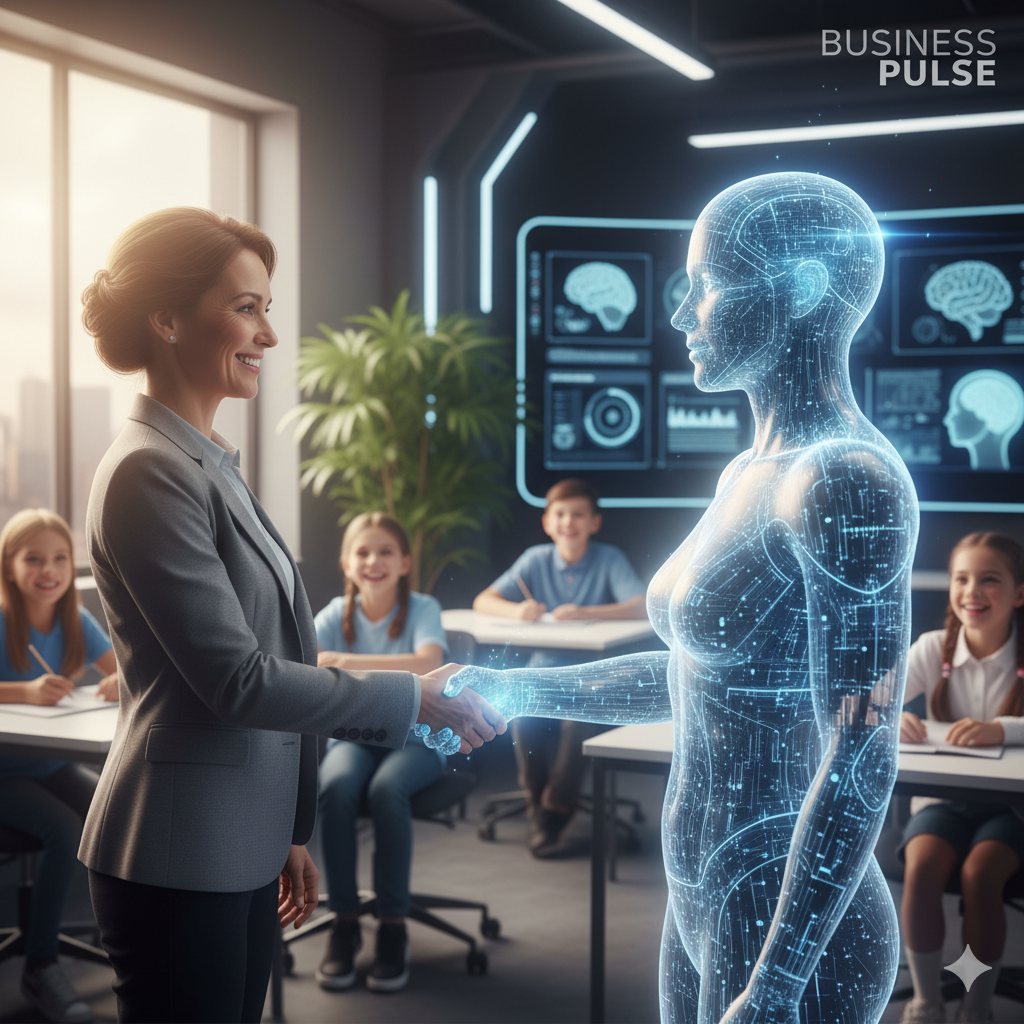Table of Contents
Toggle🤖 Artificial Intelligence in Education, AI and Teaching: Revolutionizing the Classroom Experience
📚 Introduction: The Dawn of a New Learning Era
Education has always changed in tandem with technology, from textbooks and chalkboards to smartboards and online learning environments. However, artificial intelligence (AI) is driving the largest revolution to date. 🌍✨
AI isn’t a futuristic idea anymore; it’s changing how classrooms function, how teachers instruct, and how students learn. AI now enhances, empowers, and supports teachers rather than taking their place.
Let’s examine how artificial intelligence (AI) is changing education, the top AI tools on the market, and how teachers worldwide are utilizing this advancement to create more intelligent and interesting learning experiences. 🚀
🧠 What Is AI in Education?
In education, artificial intelligence (AI) refers to intelligent systems that are able to analyze data, modify content, and carry out cognitive tasks that are typically completed by humans.
Put more simply, AI assists educators with
-
✏️ Grading and assessment
-
📖 Lesson planning and content generation
- 🎧 Accessibility for diverse learners
-
💬 Personalized tutoring and support
-
📊 Student performance analysis
AI functions as a virtual co-teacher, available around-the-clock, incredibly patient, and tailored to each student.
👩🏫 How AI Empowers Teachers
Teachers now rely on artificial intelligence to help them create more intelligent, inclusive, and personalized learning experiences in addition to saving time. Let’s examine the six main ways AI supports educators, the best resources available, and how they function in actual classrooms.. 🌍✨

🧾 1. Automated Grading and Feedback
Teachers can spend hours grading assignments and tests, but AI tools are revolutionizing this process by automatically evaluating student work and giving immediate feedback.
🔧 Top AI Tools for Grading & Feedback
🧮 Gradescope
- Gradescope, created by Turnitin, reads handwritten or typed responses using machine learning and automatically compares them to grading criteria.
- To ensure consistency and fairness, teachers can modify rubrics or review flagged answers while on the go.
- best suited for short-answer tests and subjects like science and math.
💬 ChatGPT (OpenAI) & Google Gemini
- These conversational AIs are able to provide tailored feedback, clarify mistakes in student work, and point out areas that need work.
- Instructors can save time while maintaining high-quality feedback by pasting student work, and the AI will immediately offer helpful criticism.
🧠 Turnitin with AI Detection
- Turnitin’s AI system examines originality, coherence, and structure in addition to plagiarism.
- It assists teachers in determining whether an assignment demonstrates real student effort or AI involvement.
✨ Why it matters: Instructors can devote more time to mentoring, advising, and motivating students rather than grading.
🧩 2. Smarter Lesson Planning & Content Creation
AI technologies speed up, enhance creativity, and enable data-driven lesson planning. Teachers can create ideas, worksheets, slides, and even classroom games in a matter of minutes rather than having to start from scratch.
🔧 Best AI Tools for Lesson Planning
🤖 ChatGPT (OpenAI)
- It helps teachers come up with lesson ideas, provide examples, clarify difficult theories, and create student-level assignments.
- In a natural, human-like tone, it can create practice questions for particular subjects or mimic class discussions.
🌐 Google Gemini (formerly Bard)
- creates visual lesson content by seamlessly integrating with Google Docs and Slides.
- able to provide summaries of subjects from various sources and recommend multimedia (pictures, graphs, or videos) to improve understanding.
🎨 Canva Magic Write
- Canva’s AI feature creates text content for worksheets, posters, and lesson slides.
- With pre-made templates and automatic formatting, educators can create eye-catching teaching resources that are ideal for infographics or presentations.
💡 Curipod
- Curipod automatically generates engaging lessons and class discussions.
- The AI creates a slide deck with polls, word clouds, and discussion questions based on the topic teachers type in, such as “climate change.”
✨ Why it matters: AI helps teachers plan smarter, not harder — turning hours of preparation into a few creative minutes.
🧠 3. Personalized Learning for Students
Personalization is AI’s greatest asset. It recognizes that every student learns differently and that some require visual aids, while others require repetition and challenge.
🔧 Leading AI-Powered Learning Platforms
🦉 Khan Academy (Khanmigo)
- An AI tutor powered by GPT technology that interacts with students in real time.
- Offers hints, explanations, and feedback tailored to each learner’s pace.
- Teachers can view progress dashboards and assign adaptive exercises.
🧩 Squirrel AI (China)
- GPT-powered AI tutor that communicates with students in real time.
- provides feedback, clarifications, and hints based on the individual pace of each learner.
- Instructors are able to assign adaptive exercises and view progress dashboards.
📘 Century Tech (UK)
- delivers genuinely customized learning experiences by fusing AI and neuroscience.
- The system automatically modifies upcoming lessons, detects knowledge gaps, and keeps track of how long students spend on each task.
🗣️ Duolingo Max
- An AI-enhanced language learning platform that mimics natural speech.
- uses GPT-powered “Explain My Answer” and “Roleplay” features to teach grammar and vocabulary in an engaging, conversational manner.
📚 Quizlet Q-Chat
- serves as a virtual study partner. Students can ask questions, take quizzes, and practice recall in chat form.
- adjusts each session to the learner’s strengths and shortcomings.
✨ Why it matters: Students receive customized, adaptive instruction, ensuring no one is left behind — or left bored.
💬 4. Student Support & AI Tutoring
AI tutors and chatbots provide round-the-clock support — like having a private tutor always ready to explain concepts or help with homework.
🔧 Top AI Tutoring Tools
💡 ChatGPT / GPT-5
- able to conversationally explain difficult subjects, making everything from Shakespeare to calculus simpler.
- Instructors utilize it for brief Q&A sessions with students or to assist with revision after class.
- Additionally, the model can create reading comprehension passages or mimic practice tests.
📚 Jasper AI
- intended for idea development and scholarly writing.
- uses lucid, original text to assist students (and teachers) in creating essays, research summaries, and instructional materials.
🎓 TutorAI
-
Allows teachers to type a topic (like “World War II”) and instantly generates a mini-course — complete with lessons, quizzes, and explanations.
-
Each topic is dynamically adapted to the learner’s skill level.
🧠 Conker AI
-
Specializes in quiz creation. Teachers enter a subject, and Conker automatically generates question sets of varying difficulty, complete with answer keys.
✨ Why it matters: AI tutoring improves self-directed learning and empowers students to ask questions without hesitation or fear.
📊 5. Data Analytics & Classroom Insights
AI transforms classroom data into meaningful insights — helping teachers make informed decisions.
🔧 Best Data-Driven Teaching Tools
📈 PowerSchool Unified Insights
- a suite of analytics that integrates information from behavior logs, tests, and attendance.
- Visual dashboards display trends within the school as well as patterns in student performance.
📊 Schoolytics
- provides teachers with concise visual summaries of student participation and assignment completion through direct integration with Google Classroom.
- tracks low participation or missing work to help identify at-risk students early.
🎥 Edpuzzle
- enables educators to add questions to videos and monitor how students respond to them.
- gives information about the portions of the video that students skip or rewatch.
🗂️ Otus
- An all-inclusive AI learning management system that integrates communication, analytics, and grading on a single platform.
- Teachers are able to track students’ academic progress over time and visually communicate it to parents.
✨ Why it matters: AI gives teachers real-time visibility into learning patterns, turning raw data into actionable teaching strategies.
🌈 6. AI and Inclusive Education
AI is about equity and accessibility, not just efficiency. Regardless of aptitude, language, or preferred method of learning, these resources support inclusive education.
🔧 Accessibility-Focused AI Tools
📖 Microsoft Immersive Reader
- An integrated feature in Microsoft Word, Edge, and Teams that highlights words, reads text aloud, and modifies spacing for legibility.
- helps students who are dyslexic or multilingual by supporting translation into multiple languages.
🗣️ Speechify
- transforms any digital text into audio that sounds natural, including PDFs and web articles.
- For auditory learners, the ability to listen to readings at different speeds enhances comprehension.
👁️ Seeing AI
- This Microsoft app tells the story of the world to students who are blind or visually impaired.
- It can identify faces, describe objects, read printed text, and even decipher math problems or graphs.
🎧 Otter.ai
- Lectures are recorded in class and automatically turned into timestamp-added text notes.
- Excellent for students who need to review lessons later or who have hearing impairments.
✨ Why it matters: AI guarantees equal access to education, enabling every student to achieve regardless of obstacles or situations.
💬 Summary
🌟AI is revolutionizing education, not just a convenience. These tools are helping teachers save time, reach every student, and make learning more meaningful—from planning and grading to tutoring and inclusion.
💡 To put it briefly, AI frees up educators to concentrate on what only people can do: encourage, connect, and foster curiosity.

🏆 The Best Overall AI Tool for Teaching in 2025
After comparing flexibility, accessibility, and versatility — the best overall AI tool for teachers in 2025 is:
🥇 ChatGPT (GPT-5)
Why it stands out:
- serves as a tutor, feedback assistant, lesson planner, and co-teacher.
- responds with context awareness and an understanding of natural language.
- able to interface with other programs (Canva, Notion, Google Workspace, etc.).
- saves a ton of time when creating content, summarizing, and grading.
- Millions of educators use it for online and in-class instruction worldwide.
Bonus Tip: Teachers use ChatGPT to:
- draft lesson plans.
- Create discussion starters or quizzes.
- Write a summary of student essays.
- Make content that is tailored to the various learning levels.
💡 It’s like having a 24/7 teaching assistant that never gets tired!
⚖️ Challenges and Ethical Concerns
While AI offers immense opportunities, there are challenges to address:
-
Data Privacy 🔒 – Schools must ensure student information is protected and compliant with global data laws.
-
Equity and Access 🌍 – Not all schools have equal access to AI tools or fast internet.
-
Overreliance on AI 🧩 – Teachers should balance AI support with creativity and human judgment.
-
Bias and Accuracy ⚙️ – AI systems must be monitored to prevent misinformation or bias.
💬 The key is balance — let AI assist, but let humans lead.
🚀 Future Trends: What’s Next for AI in Teaching?
Here’s what’s coming soon in the AI-powered classroom:
-
AI-driven Virtual Classrooms – Intelligent avatars that interact with students.
-
Predictive Learning Analytics – Systems that predict student outcomes and offer early help.
-
Gamified AI Learning – Education combined with AI-based storytelling and gaming.
-
AI for Teacher Training – Tools that analyze teaching performance and suggest improvements.
-
Emotional AI – Systems that detect student emotions via facial expressions and adapt teaching accordingly.
The future classroom will be an ecosystem where AI + Teacher = Empowered Education. 💪
💬 Voices from the Classroom
“AI doesn’t replace me — it amplifies me. I now spend more time connecting with students instead of paperwork.”
— Maria, High School Teacher
“ChatGPT helps me design creative writing activities in minutes. It’s like brainstorming with a colleague.”
— David, English Lecturer
🏁 Conclusion: The Human–AI Partnership in Education
The goal of artificial intelligence is to change education, not to replace it.
Teachers provide empathy, direction, and inspiration, while AI manages data, automation, and personalization. 🌟
They are working together to create an education system that is:
✅ Smarter
✅ Fairer
✅ More inclusive
✅ Deeply human
So as we step into the classrooms of the future, let’s remember — the best learning happens when technology and humanity teach together. ❤️




